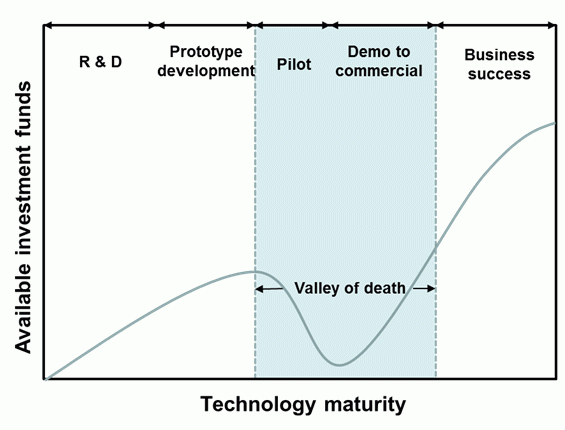Selective Cuttings
Supporting technology commercialization in the forest sector
August 6, 2013
In 1962, Nobel Laureate economist Kenneth Arrow formalized the observation that “we expect a free enterprise system to underinvest in invention and research (as compared with an ideal) because it is risky, because the product can be appropriated only to a limited extent, and because of increasing returns in use.” This original insight remains influential in discussions of innovation policy, but has been refined, particularly in reference to technology commercialization. That is, within most wealthy countries, public funds are often available to support research and development as a given technology matures from concept to prototype development, but once it comes time to construct a pilot, demonstration and/or first-commercial facility, such funding tends to be less available. Access to funding then increases again once the commercial potential of a new technology has been fully demonstrated and is able to attract private investors. This gap in available investment to demonstrate and deploy technology is typically referred to as “the Valley of death”.
The Valley of death in technology development

Within the forest sector, the effect of the valley of death is particularly apparent. In Canada, there is a well-developed innovation system for the early stages of technology development at universities, FPInnovations and within some individual firms. However, the significant costs associated with scaling a technology up to commercialization—moving it off of the work-bench or out of the laboratory—increase the risk of investment at this stage. In sectors that are relatively capital constrained, the fact that approximately 4 out of 5 technologies that make it to the pilot stage fail to be successfully commercialized makes such investments unpalatable for the vast majority of firms. In sectors driven by commodity cycles, investment funds are scarce during the bad times, and lower risk investment opportunities are plentiful during the good times. The forest sector is characterized by both of these issues; yet despite these challenges, industry and governments agree that the way forward for Canada’s forest sector includes commercializing new technologies, in order to generate new and higher-value products from wood fibre. As a result, the federal government announced the 4-year $100 million Investments in Forest Industry Transformation (IFIT) program in 2010 to provide funding within the “valley of death” and support first-commercial applications of promising technologies. By building on the success of previous federal investments in the forest sector innovation system, IFIT is ensuring that promising technologies continue to mature to business success.
